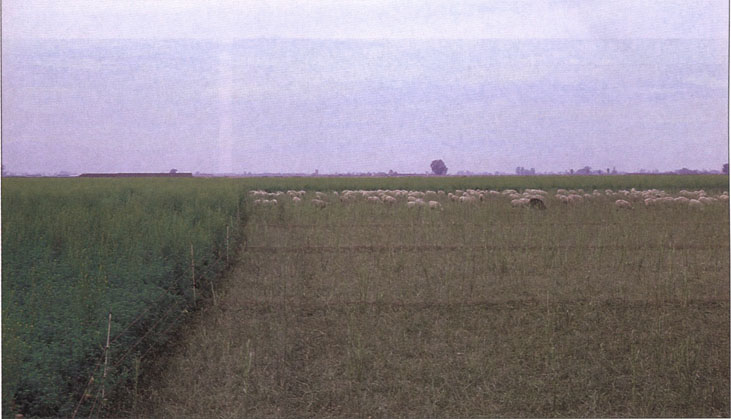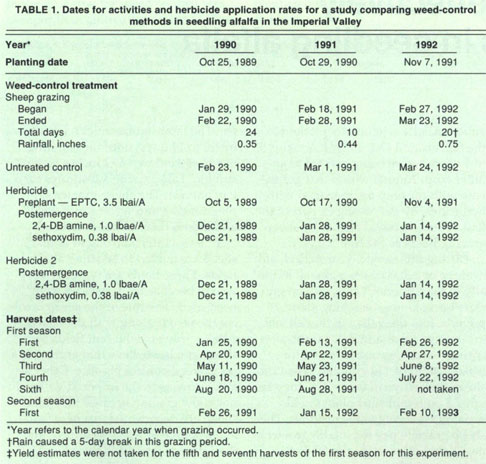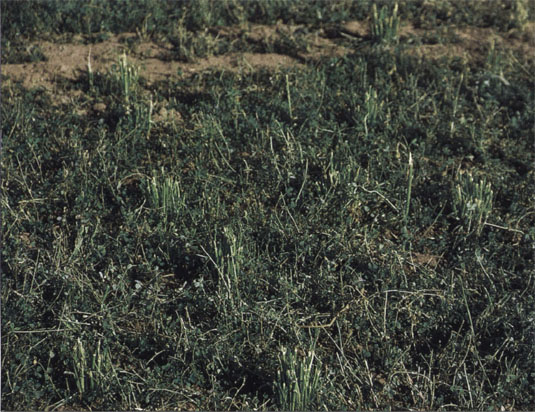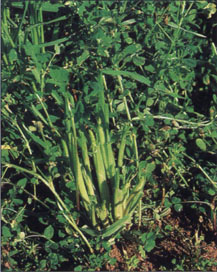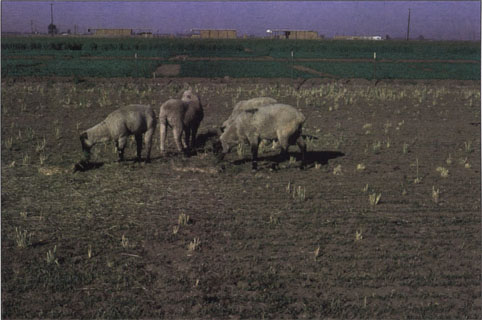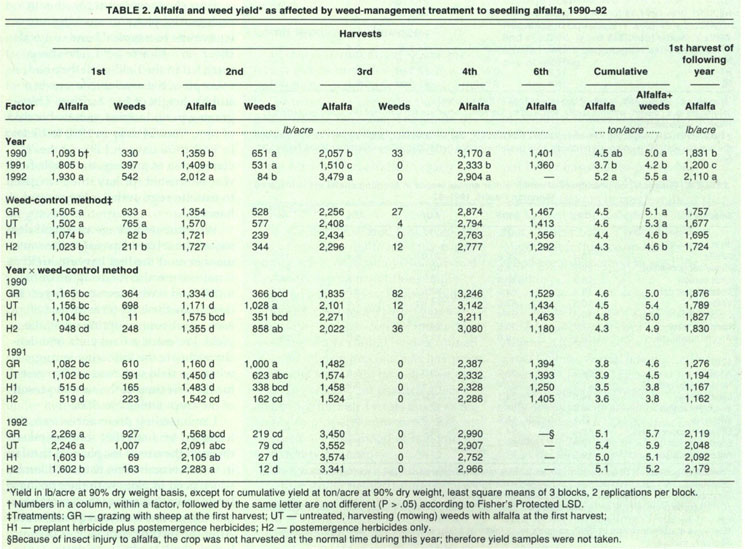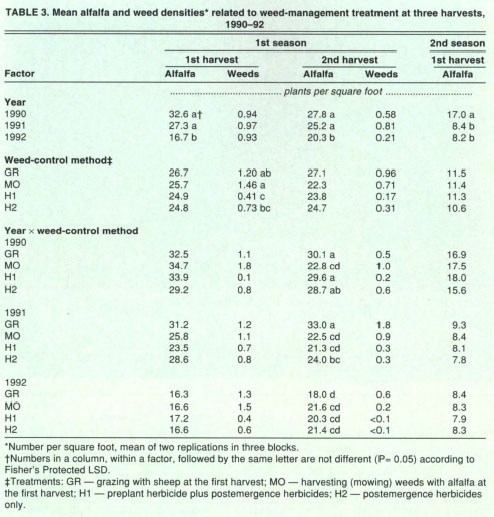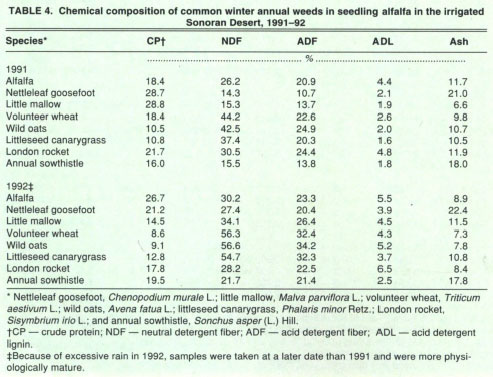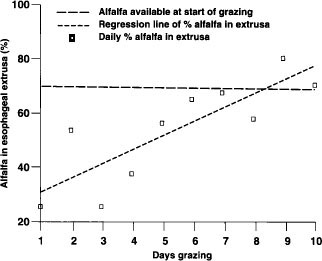All Issues
Sheep grazing effectively controls weeds in seedling alfalfa
Publication Information
California Agriculture 51(2):19-23. https://doi.org/10.3733/ca.v051n02p19
Published March 01, 1997
PDF | Citation | Permissions
Abstract
A 3-year experiment compared sheep grazing to herbicides for weed control in seedling alfalfa in the Imperial Valley. Yields for the first season were highest with the grazed treatment and the untreated control because of the contribution of weeds to the hay. There was no difference in the alfalfa forage yield and density among any of the treatments. Lambs preferred weeds to the alfalfa, and the nutritional value of the weeds was usually comparable to that of the alfalfa.
Full text
The view above shows the grazed area and the uneaten area to the left. Stems of London rocket (Systimbrium irio) can be seen along with grazed alfalfa.
The largest concentration of alfalfa in the world is reportedly in the Imperial Valley, which averaged 182,000 acres from 1990 through 1994. This amounts to 40% of the irrigated farm land in the valley. Alfalfa is generally planted in the fall, around Oct. 15, and remains 3 to 4 years before being rotated to another crop. Annual weeds that germinate with the crop are managed with herbicides, by harvesting as part of the first or second hay crops, or by sheep grazing fields as the first harvest.
During this same 5-year period, an average of 290,000 sheep grazed annually in the Imperial Valley. Sheep graziers bring lambs, weighing about 70 pounds, into the valley in the fall and graze them on alfalfa fields until spring, when they are sold at a finished weight of 130 pounds. When the sheep first arrive in the valley, they are grazed on established alfalfa fields, sudangrass or vegetable residues. The sheep graziers pay the alfalfa grower a negotiated price, typically $0.06 to $0.11 per head per day, as a pasturing fee. The lambs graze a field, usually for 10 to 14 days, until the standing hay is eaten down to 2 inches of stubble. This grazing substitutes for a hay harvest. The sheep grazier supplies fencing and water for the lambs and moves them between fields.
In late winter, starting in January, sheep are moved to seedling alfalfa fields. These fields are typically very weedy because no herbicides have been used. The role of the sheep is to eat the weeds along with the alfalfa. Alfalfa growers who rent fields for sheep grazing believe that grazing is a good weed-control practice. Other alfalfa growers in the Imperial Valley do not allow grazing because they think sheep are detrimental to a new field and a source of weed seed through their droppings and in their wool. These growers also feel that the best economic value is achieved by producing weed-free hay that sells for the highest price per ton to the dairy market. A third group of alfalfa growers are of the opinion that weed control is unnecessary — that weeds disappear from a field after the second or third harvest and do not return, and that the increased tonnage of the weedy hay offsets its lower price.
TABLE 1. Dates for activities and herbicide application rates for a study comparing weed-control methods in seedling alfalfa in the Imperial Valley
All three viewpoints on how to manage weeds in a seedling alfalfa field are strongly held by their respective growers, who seldom change their practices. Locally developed information or research to support any one viewpoint could not be found. We established an experiment to compare weed-control practices — herbicides, sheep grazing and harvesting — for their effect on alfalfa stand density, yield, and weediness of the hay. We also evaluated feeding preferences of sheep in weedy alfalfa and the feed value of common winter annual weeds growing in the area.
Four experimental treatments
The experiment was repeated 3 years at the UC Desert Research and Extension Center near Holtville. Each “year” of this experiment lasted about 16 months, starting with the planting of the alfalfa in the fall; continuing with grazing the following winter; and completing with harvests taken through the spring, summer and fall and at the first spring harvest of the second season of each crop. Each “year” of the experiment is identified by the calendar year when the grazing took place.
The four experimental treatments were two herbicide regimes, sheep grazing and an untreated control (table 1). Alfalfa in the Imperial Valley is grown on flat ground called lands, typically 70 feet wide, between raised irrigation borders. A randomized complete block design was used, with three lands serving as blocks. Two sub-block replicates were used in each block. The four treatments were randomized within each replicate of the block. Plot size was 0.1 acre. Alfalfa ‘CUF101’, the most common variety in the Imperial Valley, was sown at 20 lb/acre in the fall of each year about 0.25 inches deep, using a grain drill with a grass seeder box. The sown fields were flood-irrigated.
A thoroughly grazed plot (22 days total) in the first year of the experiment. The sheep have left no forage in the field.
TABLE 2. Alfalfa and weed yield* as affected by weed-management treatment to seedling alfalfa, 1990–92
TABLE 3. Mean alfalfa and weed densities* related to weed-management treatment at three harvests, 1990–92
TABLE 4. Chemical composition of common winter annual weeds in seedling alfalfa in the irrigated Sonoran Desert, 1991–92
Alfalfa yield and density were estimated with quadrat samples. The day before grazing began, when the alfalfa was about 12 inches tall, five subsamples, each 2.69 square feet, were harvested by hand clipping at 2 inches in each plot. In each subsample, weeds and alfalfa were separated by species, placed in paper bags, dried in a forced-air oven at 122°F for 72 hours and then weighed. The number of alfalfa and weed plants in each quadrat were counted when they were clipped.
Four sheep were put together in each grazed plot; this stocking rate is equivalent to a typical band of 1,600 sheep on a 40-acre field. The sheep were left in the field until they had eaten all of the available forage to a stubble height of 1 to 2 inches. This grazing period varied, mostly because of rain, from 24 days in 1990 to 10 days in 1991 to 20 days in 1992. At the completion of grazing, the whole field was harvested for hay, then irrigated to initiate regrowth for the second harvest.
We estimated forage yield and density at the second harvest in the same manner as at the first harvest. Yield estimates were also made at the third, fourth and sixth harvests each year to determine the long-term impact of each weed-control option on alfalfa yield. We made a final yield and density estimate the following spring when the field was ready to harvest for the first time in the second season of the crop (tables 2 and 3).
Lamb feeding preferences were determined by analyzing samples taken through the use of esophageal fistulas in three animals. One fistulated lamb was placed in plots with the grazing lambs in each block each day of the grazing period for about a half-hour. After the feeding sample was collected, these lambs were put in a nearby paddock with forage similar to that of the experimental lambs. A small subsample of the extrusa collected was floated in a shallow dish of water, and the weed and alfalfa particles were picked out separately. Each sample was dried and weighed to make a quantitative estimate of the percentages of alfalfa and weeds being eaten by the lambs on a daily basis. The nutritional value of the alfalfa and the weeds was determined in the laboratory from plants cut in the fields being grazed (table 4). We analyzed both weeds and alfalfa for crude protein, ash, neutral detergent fiber (NDF), acid detergent fiber (ADF) and acid detergent lignin.
Alfalfa yield and density
We included the year of the experiment as part of our statistical model because we expected it to have an important influence on results. In many cases, year was the most significant factor affecting crop density, hay yield and weediness (tables 2 and 3). Alfalfa farmers are well aware of the unpredictable effect of “year” (that is, factors such as weather, pests and farming practices) on crop production.
Weed control achieved with the two herbicide regimes was very good in all 3 years of the experiment. Weed density and yield were lower than in the grazed or untreated control plots at the first harvest. Herbicide treatment reduced forage yield an average of 550 pounds at the first harvest, compared to the grazed and untreated control. In two of the years, 1991 and 1992, crop injury from 2,4-DB reduced alfalfa growth 50% and 33%, respectively.
In 1990, the year with the longest sheep-grazing period, weed yield and density at the second harvest in the grazed plots were comparable to those under herbicide treatment. Conversely, the year with the shortest grazing period, 1991, had the highest amount of weeds in the forage at this harvest. There was more variability between treatments and years at the second harvest than at any other harvest. Weed species that were most common at the second harvest were annual sowthistle, little mallow and wild oats. There were no differences related to treatment at the third, fourth or sixth harvest, and there were very few weeds in the hay.
Total alfalfa yield for the first season, not including the weeds, was almost equal between weed-control methods. Alfalfa forage yield and density, when measured at the first harvest of the second season of the crop, were also not affected by weed-control method, although there were year differences (table 2, table 3). There were no weeds at this harvest.
Lamb feeding preferences
In this experiment, the lambs preferred weeds to alfalfa (fig. 1). It was not until the eighth day of grazing that the samples obtained from the lambs had the same percentage of alfalfa as was originally available in the field. Chemical analysis of the weeds compares favorably to alfalfa in many cases (table 4).
Conclusions
It was demonstrated that weed control in seedling alfalfa has only a temporary effect on alfalfa yield and quality, under typical conditions in the Imperial Valley. In fact, weed control reduces total forage yield. Therefore, the choice of weed-control method in seedling alfalfa should be determined by economic factors (such as hay price, discounts for weedy hay, the cost of spraying weeds and pasturing fees) and by agronomic factors (such as the ability to properly cure weedy hay in the field, the likelihood of rain and the availability of sheep).
Sheep readily consumed weeds in seedling alfalfa fields, usually in preference to the alfalfa. Sheep did as good a job of weed control as herbicides. Sheep represent an alternative weed-control method for seedling alfalfa in the Imperial Valley. Chemical analysis of common winter weeds in the Imperial Valley shows that they have nutritive values similar to alfalfa and do not lower hay quality per se. No weeds were present that are known to cause off-flavors in cow's milk or that are known to be toxic to livestock; either of these factors would have an important influence on the choice of weed-control method in seedling alfalfa.
Fig. 1. Percent alfalfa consumed by grazing lambs as determined from esophageal extrusa, means of 1991 and 1992. The percentage of alfalfa available at start of grazing averaged 69.4% over 1991 and 1992. Regression equation: Y = 25.49 + 5.23(X) and r2 = 0.70 (r = 0.8353643) where Y = % alfalfa in lamb esophageal extrusa, X = day of grazing.



